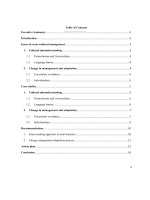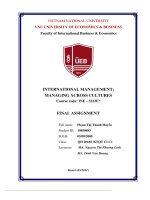Managing chest drainage
Bạn đang xem bản rút gọn của tài liệu. Xem và tải ngay bản đầy đủ của tài liệu tại đây (3.24 MB, 63 trang )
Managing
Chest Drainage
What you will learn
• Anatomy & physiology of the chest relating
to chest drainage
• Mechanics of breathing
• Conditions requiring pleural chest drainage
• Chest drain basics (3 bottle systems)
• Disposable chest drains
Thoracic cavity
• This space is defined by:
–
–
–
–
Sternum anterior
Thoracic vertebrae posterior
Ribs lateral
Diaphragm inferior
• “Chest wall” composed of
ribs, sternum, thoracic
vertebrae interlaced with
intercostal muscle
• The diaphragm is the “floor”
of the thoracic cavity
Thoracic cavity
•
•
•
Right lung
Left lung
Mediastinum
– Heart
– Aorta and great
vessels
– Esophagus
– Trachea
– Thymus
Breathing: inspiration
• Brain signals the phrenic
nerve
• Phrenic nerve stimulates the
diaphragm (muscle) to
contract
• When diaphragm contracts,
it moves down, making the
thoracic cavity larger
(keep this in mind as we discuss
physics)
How does air move into the lungs?
• Physics is phun!
– If you understand the principles of gas flow,
you will understand chest drainage
– As pressures change, air moves
Physics of gases
• Air is made up of gas molecules
• Gas molecules in a container collide and create
a force
• Pressure is the amount of the force created by
the gas molecules moving and colliding
Physics of gases: Boyle’s law
When temperature is constant, pressure is
inversely proportional to volume
Physics of gases: Boyle’s law
• When the volume of a container increases,
the pressure decreases
• When the volume of a container decreases,
the pressure increases
• If you’re trying to squeeze as many people in
a car as possible, they will be under much
higher pressure in a VW Beetle than the
same number of people would be in a
minivan
Physics of Gases
If two areas of different pressure
communicate, gas will move from the area
of higher pressure to the area of lower
pressure
This movement of air causes
wind when a high pressure
system is near a low pressure
system in the atmosphere
Physics of Gases
Another example…
• Inflated balloon = HIGH (POSITIVE)
PRESSURE
• Atmosphere = LOW PRESSURE
• Pop the balloon, and air rushes from
an area of high pressure inside the
balloon to the low pressure in the
atmosphere
Breathing: inspiration
• When the diaphragm contracts, it
moves down, increasing the
volume of the thoracic cavity
When the volume increases, the
pressure inside decreases
• Air moves from an area of higher
pressure, the atmosphere, to an
area of lower pressure, the lungs
• Pressure within the lungs is
called intrapulmonary pressure
Breathing: exhalation
• Exhalation occurs when the
phrenic nerve stimulus stops
• The diaphragm relaxes and
moves up in the chest
• This reduces the volume of the
thoracic cavity
• When volume decreases,
intrapulmonary pressure
increases
• Air flows out of the lungs to the
lower atmospheric pressure
Breathing
• Remember, this is normally an
unconscious process
• Lungs naturally recoil, so exhalation
restores the lungs to their resting position
• However, in respiratory distress,
particularly with airway obstruction,
exhalation can create increased work of
breathing as the abdominal muscles try to
force air out of the lungs
Pleural anatomy
Lungs are surrounded by
thin tissue called the
pleura, a continuous
membrane that folds over
itself
– Parietal pleura lines the
chest wall
– Visceral pleura covers the
lung (sometimes called the
pulmonary pleura)
Pleural anatomy
Visceral pleura
Normally, the two
membranes are
separated only by
the lubricating
pleural fluid
Fluid reduces
friction, allowing
the pleura to slide
easily during
breathing
Parietal pleura
Lung
Intercostal
muscles
Ribs
Normal Pleural Fluid Quantity:
Approx. 25mL per lung
Pleural physiology
• The area between the pleurae is called the pleural
space (sometimes referred to as “potential space”)
• Normally, vacuum (negative pressure) in the
pleural space keeps the two pleurae together and
allows the lung to expand and contract
• During inspiration, the intrapleural pressure is
approximately -8cmH20 (below atmosphere)
• During exhalation, intrapleural pressure is
approximately -4cmH20
Pressures
• Intrapulmonary pressure (the pressure in the lung)
rises and falls with breathing
• Equalizes to the atmospheric pressure at endexhalation (defined as 0 cmH2O because other
pressures are compared to it as a baseline)
• Intrapleural pressure also fluctuates with breathing
~ 4 cmH2O less than the intrapulmonary pressure
• The pressure difference of 4 cmH2O across the
alveolar wall creates the force that keeps the
stretched lungs adherent to the chest wall
When pressures are disrupted
Intrapleural pressure: -8cmH20
If air or fluid enters the
pleural space between
the parietal and visceral
pleura, the -4cmH20
pressure gradient that
normally keeps the lung
against the chest wall
disappears and the lung
collapses
Intrapulmonary pressure:
-4cmH20
Conditions requiring chest
drainage
Visceral pleura
Pleural space
Air between the
pleurae is a
pneumothorax
Parietal pleura
Conditions requiring chest
drainage
Blood in the pleural
space is a
hemothorax
Conditions requiring chest
drainage
Transudate or
exudate in the
pleural space is a
pleural effusion
Conditions requiring chest drainage:
pneumothorax
• Pneumothorax
– Occurs when there is an opening on the
surface of the lung or in the airways, in the
chest wall — or both
– The opening allows air to enter the pleural
space between the pleurae, creating an
actual space
Conditions requiring chest drainage:
open pneumothorax
• Open pneumothorax
– Opening in the chest
wall (with or without
lung puncture)
– Allows atmospheric air
to enter the pleural
space
– Penetrating trauma:
stab, gunshot,
impalement
– Surgery
Photo courtesy trauma.org
Conditions requiring chest drainage:
closed pneumothorax
• Closed pneumothorax
– Chest wall is intact
– Rupture of the lung
and visceral pleura (or
airway) allows air into
the pleural space









